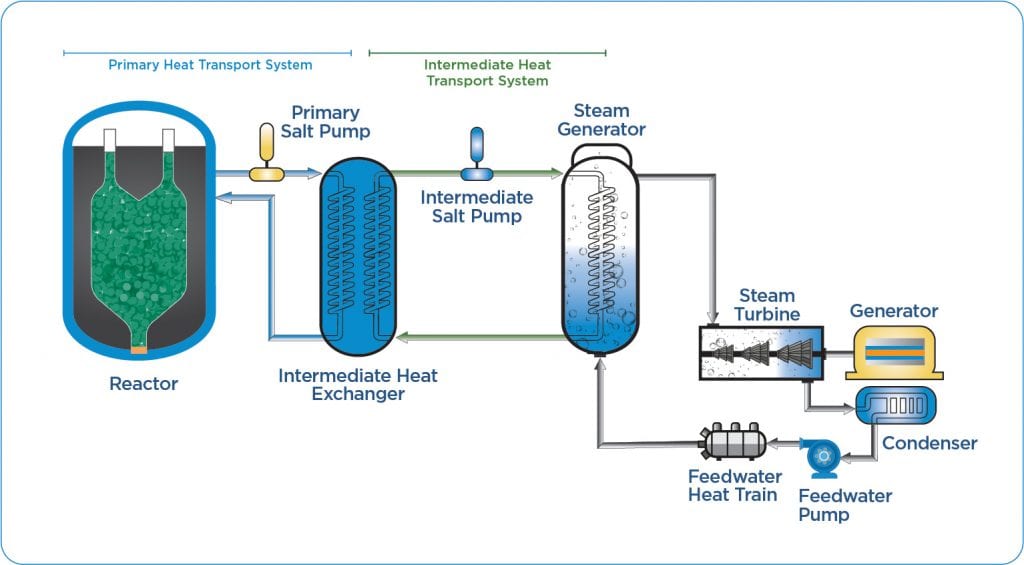NRC Completes Safety Review for Kairos Nuclear Test Reactor Within 18 Months
The Nuclear Regulatory Commission (NRC) has wrapped up a final safety evaluation for Kairos Power’s 35-MWth Hermes “non-power” demonstration reactor, which the firm has proposed to build at the East Tennessee Technology Park Heritage Center site in Oak Ridge, and plans to begin operating by 2026.
The NRC’s review, which concluded “no safety aspects that would preclude issuing the construction permit” for the proposed reactor, was completed in 18 months. While the NRC said it conducted a “thorough” safety review for the first-of-a-kind reactor, the review was notably completed “well ahead of schedule,” noted Andrea Veil, director of the NRC’s Office of Nuclear Reactor Regulation. “This reflects the NRC’s commitment to maintaining safety, by applying risk-informed approaches, while improving efficiency.”
A Big Milestone for Hermes, a Scaled Advanced Reactor Demonstration Plant
Hermes, a scaled advanced reactor demonstration plant, will support development of Kairos’s fluoride salt-cooled, high-temperature reactor (KP-FHR) technology. KP-FHR technology essentially comprises a graphite-moderated, “randomly packed” pebble‐bed reactor with a Flibe molten fluoride salt coolant. Kairos envisions the KP-FHR reactors will operate at high temperatures and near‐atmospheric pressures.
The fuel in the KP-FHR is based on tri-structural ISOtropic (TRISO) particle fuel in pebble form with a carbonaceous‐matrix coated particle design. It will contain high-assay low-enriched uranium (HALEU). “The fuel kernel and some of the coatings on the particle fuel provide retention of fission products. TRISO particles are dispersed within the graphite matrix of fuel pebble’s fuel layer,” the company has said.

The NRC in November 2021 accepted Kairos’s construction permit application (CPA) submitted under 10 CFR Part 50.21 (a class of licenses for medical therapy and research and development facilities). Kairos expects that the regulatory body will issue a construction permit in fall 2023, noting that the NRC committed to an accelerated 21-month review timeline.
Staff is on track to complete a final environmental impact statement (EIS) in September 2023, the NRC said last week. The final safety evaluation and EIS will then go to the commission for a mandatory hearing phase of the licensing process, and the commission will vote on whether to authorize the permit.
The CPA notably represents the NRC’s first application with functional containment, buoyancy of the fueled pebbles and graphite reflector in the Flibe coolant, and a spherical TRISO particle shell in a pebble that is smaller than those used in German and Chinese high temperature reactors, among several other unique features.
‘A Rapid Iterative Development Approach’
Kairos said the efficient review stems from a “rapid iterative development approach” that builds upon “extensive pre-application engagement” with the NRC beginning in 2018. “We believe this was due in large part to our regular communication with NRC staff, a submission backed by data, and our demonstrated capacity to manufacture real hardware and test it,” the company said on June 15.
“We are pleased to have worked closely with the NRC staff to complete a thorough, efficient, and innovative review, which is encouraging for future deployment of advanced nuclear reactors,” said Peter Hastings, Vice President of Regulatory Affairs. “We look forward to continuing our close collaboration with the staff and the Commission to support the Final Environmental Impact Statement and complete the mandatory hearing.”
For Kairos, the Hermes CPA also pivotally lays the groundwork for an operating license application, which should also inform license applications for future commercial deployments. When ultimately completed as envisioned by 2026, Hermes will demonstrate other key technical elements, design features, safety functions, and equipment performance for the KP-FHR technology.
To prepare for the construction and operation of Hermes—which is Kairos’ first nuclear iteration—the company is making headway on the Engineering Test Unit (ETU), a non-nuclear, unenriched Flibe-wetted, and isothermal integrated test, at Kairos’s KP-Southwest research and development facility in Albuquerque, New Mexico. In tandem, the company is producing Flibe for the ETU program at its Molten Salt Purification Plant (MSPP) at Materion’s campus in Elmore, Ohio.
“Flibe, a chemically stable, molten mixture of lithium fluoride and beryllium fluoride salts, is integral to KP-FHR technology,” the company notes. In May, the company shipped its first batch of unenriched Flibe to its Albuquerque testing facility. The Flibe will be loaded into ETU and circulated at temperature, generating data and learnings that will inform subsequent iterations on our path to commercial deployment.
“Building and operating MSPP has yielded valuable experience and data that will support Flibe production for the commercial KP-FHR fleet. By initiating and exercising the supply chain for critical materials like Flibe in an early stage of development, Kairos Power will be able to deliver our advanced reactor technology with cost certainty. It’s one of many reasons we embrace an iterative approach, which goes hand-in-hand with our vertical integration strategy to produce critical components in-house,” the company said.
Kairos on Feb. 9 also announced it had signed a memorandum of understanding with UrencoUSA to collaborate on a “path forward to securing a HALEU supply” for future commercial reactors.
To date, 31 licensed research and test (nonpower) reactors operate in 21 states. The NRC is in parallel reviewing a CPA for Abilene Christian University’s (ACU’s) Molten Salt Research Reactor. When it accepted ACU’s CPA in November 2022, the NRC said it expects to complete its environmental and safety reviews by May 2024. If completed as envisioned by the end of 2025, ACU’s proposed Nuclear Energy eXperimental Testing (NEXT) Laboratory would be one of the first university-based molten-salt research reactors in the U.S. It would also be “the first university research reactor of any kind in the last 30 years,” ACU noted. The NRC is also engaged in pre-application topical report reviews for Atomic Alchemy, which proposes to construct a nonpower reactor for radioisotope production.
—Sonal Patel is a POWER senior associate editor (@sonalcpatel, @POWERmagazine).